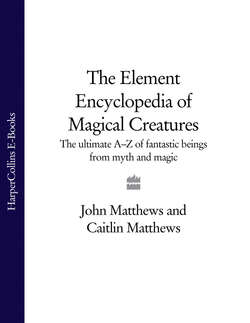Читать книгу The Element Encyclopedia of Magical Creatures: The Ultimate A–Z of Fantastic Beings from Myth and Magic - John Matthews - Страница 111
ANUBIS
ОглавлениеThe great jackal-headed god of ancient Egyptian mythology. He was the guardian of tombs and patron of embalming, and shared with the god Thoth the task of conducting the dead into the judgment halls of Amenti. There he weighed the hearts of the dead against the father of truth. Anubis was originally seen as a god of the Underworld but was replaced later by Osiris, becoming, with his brother Upuaut, a son or attendant of the newer god. He is generally portrayed in canine form, though the species, whether dog or jackal, has yet to be accurately identified. He is always shown with a jet-black coat, which represents the discoloration of the body after it is soaked in a solution of the carbonate salt natron during the process of mummification. Black also suggests the fertility of the soil and is the colour of the alluvial Nile silt, which produces the rich harvests of the area.
Anubis sometimes appears anthropomorphically in the form of a man with an animal’s head. One Egyptian papyrus derives his name from the verb ‘to putrefy’; whether this is accurate or not, Anubis’ role probably began with an observation of desert dogs scavenging for bodies in the shallow graves dating from the pre-dynastic period. Anubis was seen as guarding the mummies of recently deceased people from evil forces, enabling them to make the journey to the Otherworld in safety, and his image is often found painted on the doors of tombs or the lids of sarcophagi. Priests responsible for the rituals of embalming often wore an Anubis mask and acted as the god’s earthly representative. In the oldest strata of Egyptian mythology, Anubis is a child of Nephthys, or, in later texts, of Isis and Osiris. In the story of the death and resurrection of Osiris, Anubis was responsible for embalming the body until Isis brings it back to life.
Anubis’ many titles not only indicate his importance in Egyptian religious traditions but also his function. He is known as Khenty-imentiu (‘The foremost of the Westerners’), suggesting his rulership over those buried in the cemeteries along the west bank of the Nile. One ancient text shows Anubis in the act of burying a body in a heap of sand facing west. He is also known as Khenty-seh-Netjer (‘One who presides over the gods’ pavilion’). The effigy of Anubis discovered in Tutankhamun’s tomb represents him crouching on a shrine or pavilion decorated with symbols representing the god. Another title is Tepy-dju-ef, meaning ‘One who is upon his mountain’. This suggests Anubis watching over the dead from the heights of the cliffs overlooking the cemeteries where they were buried. He is also known as the ‘Lord of the Sacred Land’, emphasizing again his connection to the landscape. Papyri from the Graeco-Roman period show that Anubis was eventually transformed into a cosmic deity ruling over the sky and Earth. He is even seen as bringing light to the human race, and latterly as manufacturing effective love potions. On the walls of the catacombs of Alexandria, Anubis is dressed in armour as a warrior and acts as a guardian to Osiris. The Greeks identified Anubis, with Hermes, as the being who represented wisdom.
